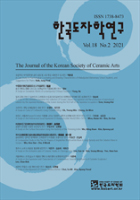중국 용산 흑도 예기의 조형과 장식 연구
Research on the Modeling and Decoration of Chinese Longshan Black Pottery
- 한국도자학회
- 한국도자학연구
- Vol.20 No.2
-
2023.08101 - 122 (22 pages)
-
DOI : 10.22991/ksca.2023.20.2.101
- 117

산동 용산 흑도 예기에는 선조들의 사회생활 형태와 정신형태, 그리고 당시에 도달할 수 있는 가장높은 수준의 과학기술 문명과 예술적 문명 형태가 응축되어 있다. 이는 더 이상 실용적인 기물에 그치지 않고 나아가 다양한 문화의 정보 그리고 실용성, 심리, 철학적 의미 등 다양한 문화의 요소가 담긴매개체가 되었다. 용산문화 흑도 예기에는 실용적 기능과 심미적 의미가 모두 중시되고, 예술적 창조와 공예적 혁신이 동일시 되며, 조형과 장식이 상호보완하고, 문자와 이미지가 공존하는 특징이 있어중요한 가치를 지님으로써 오랫동안 영향을 주었다. 다양하게 변화하고 특징이 두드러진 흑도 예기에조형은 모든 것을 포용하고 이전 시기의 제작 경험과 각종 생활 속의 양분을 흡수한 결과이다. 흑도예기는 비록 조형이 주도적인 지위를 점하고 장식은 부차적인 요소로 여겨졌지만, 각종 리듬감이 가득한 현문, 수문, 획문 등 기하학적 문양과 투조 장식 기법을 통해 기물에 독자적인 장식 미감을 부여했고, 이로써 흑도의 독특한 장식 풍격을 형성하였다. 본문은 사례분석법, 문헌연구법 등 연구방법을 활용하여 흑도 예기에 담긴 순수하고, 간단하고, 소박하고, 조화로운 조형예술의 가치를 정리해냈다. 게다가 용산문화 흑도 예기의 장식 특징을 연구함으로써 공예를 도문법과 루각(鏤刻)법으로 나누었으며, 소재는 구상과 추상 두 종료로 구분하였다. 게다가 세분화된 유형에 대해 정리 및 연구를 진행하였다. 그리하여 상술한 내용과 같이 용산문화 흑도 예기에 관한 모든 내용을 탐구하여 그 안에 담긴 의미를몸소 체득하였고, 이로써 문화적 소양을 바탕으로 표현된 표층 예술을 이해할 수 있었다.도자기 문화예술의 우수성을 논하고자 할 때, 흑도는 우리 선조들이 물 려준 위대한 문화유산으로서의 가치를 인정받고 있다. 그러나 중국의 현대 도 예의 다년간의 발전과정에서 흑도가 전승과 재현이라는 인식을배태한 채 답보상태에 머물러 왔다. 본 연구에서는 중국 용산흑도예기조형의 장르분류과 장식 제작에대한 이론적 배경을 살펴보았다. 이와 더불어 본 연구를 통해 일부 현대 도예 조형과 장식 디자인의새로운 구상을 확대하고, 현대 도예에 적합한 용산 흑도 예기의 표현 형식을 탐구하며, 한국과 중국현대 도예 디자인의 발전에 긍정적인 추진 역할을 하고자 한다.
The black pottery sacrificial vessels in Longshan, Shandong Province, embody the social life and spiritual form of the ancestors, as well as the highest scientific and technological civilization and artistic civilization that can be achieved at that time. It is not only a practical tool, but also a carrier of information of multiple civilizations. It is also the carrier of many cultural elements such as practical, aesthetic and philosophical implications. The characteristics of the black pottery sacrificial vessels of Longshan culture, which emphasize both practical functions and aesthetic implications, artistic creation and technological innovation, complementary modeling and decoration, and the coexistence of text and image, make its value profound and far-reaching. The black pottery sacrificial vessels, which are full of changes and features, are the result of embracing and fully absorbing the previous experience in making utensils and various nutrients of life. Although the black pottery ritual ware is dominated by the shape and the decoration is in the secondary position, various rhythmic geometric patterns such as string patterns, water patterns, and lines, as well as carving and other decorative means, have given the unique decorative beauty of the utensils and formed the unique decorative character of the black pottery. This paper adopts case analysis, literature research and other research methods, combined with the existing black pottery ritual objects, analyzes the bionic modeling characteristics of black pottery ritual objects, the curved and straight interpenetrating modeling characteristics, and the black modeling characteristics, and summarizes the pure, simple, simple, and harmonious plastic art values contained in black pottery ritual objects; To study the decorative characteristics of black pottery sacrificial vessels of Longshan culture, the process can be divided into patterning method and carving method, and the subject matter is concrete and abstract, and its subdivision types are summarized and studied. From the inside to the outside, we can understand the connotation and better understand the surface art represented by the cultural heritage.When discussing the excellence of ceramic culture and art, the value of the underworld as a great cultural heritage left by our ancestors has been recognized. However, during the years of development of modern ceramic art in China, the understanding that the underworld is inherited and reproduced has been nurtured, and has always been in a state of standing still. This study examined the theoretical background of genre classification and decorative production of black pottery shapes in Longshan, China. At the same time, through this study, some new ideas for modern ceramic modeling and decoration design were expanded, and the expression forms of Longshan black pottery suitable for modern ceramic art were explored, hoping to play a positive role in promoting the development of modern ceramic design in South Korea and China.
Ⅰ. 서론
Ⅱ. 본론
Ⅲ. 결론
참고문헌
(0)
(0)